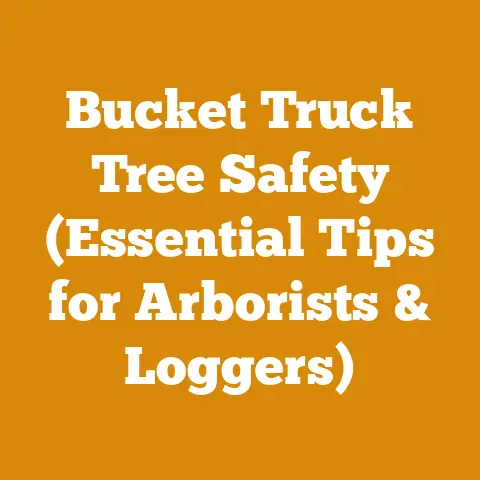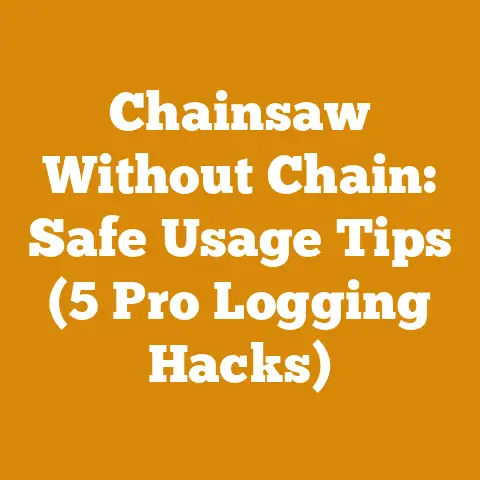Brush Cutter Harness Guide (5 Expert Tips for Safer Wood Cutting)
Imagine this: You’re wrestling with a stubborn patch of overgrown brush, sweat stinging your eyes, your back screaming in protest with every swing of the brush cutter. The vibration rattles your teeth, and you feel like you’re about to lose control of the machine. Now, picture this instead: You’re gliding through the same thicket, the brush cutter feeling like an extension of your own body. The weight is distributed evenly, your movements are fluid and controlled, and you’re making quick, clean work of the task at hand. No back pain, no aching arms, just efficient, safe, and satisfying progress. The difference? A properly fitted and utilized brush cutter harness.
That transformation, from struggling amateur to confident professional, is what I aim to achieve for you in this guide. I’ve spent years clearing land, managing forests, and prepping firewood, and I’ve learned firsthand how crucial the right equipment and techniques are. A brush cutter harness isn’t just an accessory; it’s a vital piece of safety gear that can dramatically improve your efficiency, reduce fatigue, and, most importantly, prevent serious injuries.
Brush Cutter Harness Guide: 5 Expert Tips for Safer Wood Cutting
In this guide, I’ll share my top five expert tips for using a brush cutter harness safely and effectively. We’ll delve into the different types of harnesses available, how to properly adjust them for optimal weight distribution, essential safety precautions, and even some advanced techniques for maneuvering in challenging terrain. Whether you’re a seasoned professional or a weekend warrior tackling your overgrown backyard, this guide will equip you with the knowledge and skills you need to master your brush cutter and work with confidence.
1. Understanding the Importance of a Brush Cutter Harness
Before diving into the specifics, let’s understand why a brush cutter harness is so essential. A brush cutter, also known as a clearing saw or brush saw, is a powerful tool designed for cutting through thick brush, weeds, and even small trees. It consists of a rotating blade or cutting head attached to a long shaft, powered by a gasoline engine or electric motor. This power and reach come at a cost: significant weight and vibration.
Without a harness, you’re forced to support the entire weight of the brush cutter with your arms and back. This leads to rapid fatigue, reduced control, and increased risk of injury. The constant vibration can also cause long-term damage to your hands and arms, a condition known as Hand-Arm Vibration Syndrome (HAVS).
Key Benefits of Using a Brush Cutter Harness:
- Reduced Fatigue: By distributing the weight of the brush cutter across your shoulders, back, and hips, a harness significantly reduces strain on your arms and back, allowing you to work for longer periods without fatigue.
- Improved Control: A harness provides a stable platform for operating the brush cutter, allowing you to make more precise cuts and maintain better control of the machine.
- Enhanced Safety: By reducing fatigue and improving control, a harness reduces the risk of accidents and injuries. It also allows you to react more quickly to unexpected situations.
- Increased Efficiency: With less fatigue and better control, you can work more efficiently and cover more ground in less time.
- Prevention of Long-Term Injuries: A harness helps to prevent repetitive strain injuries, such as carpal tunnel syndrome and tendonitis, as well as vibration-related injuries like HAVS.
My Personal Experience:
I remember one particularly grueling project where I was tasked with clearing a large area of overgrown brush without a harness. After just a few hours, my arms were aching, my back was screaming, and I was struggling to maintain control of the brush cutter. My cuts were sloppy, and I felt like I was one wrong move away from an accident. It was a miserable experience, and I vowed never to work without a harness again. Since then, I’ve invested in a high-quality harness and learned how to adjust it properly, and the difference has been night and day. I can now work for hours without fatigue, my cuts are cleaner, and I feel much safer and more in control.
2. Choosing the Right Type of Brush Cutter Harness
Not all brush cutter harnesses are created equal. There are several different types available, each with its own advantages and disadvantages. The best type of harness for you will depend on your specific needs and preferences, as well as the type of brush cutter you’re using.
Types of Brush Cutter Harnesses:
- Single Shoulder Harness: This is the simplest and most affordable type of harness. It consists of a single strap that goes over one shoulder and attaches to the brush cutter. Single shoulder harnesses are lightweight and easy to use, but they provide limited weight distribution and are best suited for light-duty tasks.
- Double Shoulder Harness: This type of harness features two straps that go over both shoulders, providing better weight distribution and stability than a single shoulder harness. Double shoulder harnesses are a good choice for general-purpose brush cutting tasks.
- Vest-Style Harness: Vest-style harnesses offer the best weight distribution and support. They consist of a vest that covers the torso and shoulders, with straps that attach to the brush cutter. Vest-style harnesses are ideal for heavy-duty brush cutting tasks and for users who experience back pain or fatigue.
- Hip Belt Harness: Some harnesses incorporate a hip belt to further distribute the weight of the brush cutter to the hips and legs. This can be particularly helpful for users who spend long hours operating a brush cutter.
Factors to Consider When Choosing a Harness:
- Weight of the Brush Cutter: If you’re using a heavy brush cutter, you’ll need a harness that can handle the weight and distribute it effectively.
- Type of Brush Cutting Tasks: For light-duty tasks, a single shoulder harness may suffice. For heavy-duty tasks, a vest-style harness is recommended.
- Comfort: Choose a harness that is comfortable to wear for extended periods. Look for features like padded shoulder straps and breathable materials.
- Adjustability: A good harness should be easily adjustable to fit your body size and shape.
- Durability: Choose a harness made from durable materials that can withstand the rigors of brush cutting.
- Price: Brush cutter harnesses range in price from around \$30 to over \$200. Consider your budget and choose a harness that offers the best value for your money.
My Recommendation:
For most users, I recommend a double shoulder harness or a vest-style harness. These types of harnesses provide a good balance of weight distribution, comfort, and durability. If you’re using a particularly heavy brush cutter or if you experience back pain, a vest-style harness with a hip belt is the best option.
Example:
I use a Stihl FS 560 C-EM clearing saw, which is a powerful and relatively heavy machine. I’ve found that a Stihl ADVANCE X-TREEm harness (vest style) provides excellent support and weight distribution, allowing me to work comfortably for hours without fatigue. The padded shoulder straps and breathable materials make it comfortable to wear, and the adjustable straps ensure a secure and customized fit.
3. Properly Adjusting Your Brush Cutter Harness: The Key to Comfort and Safety
Once you’ve chosen the right type of brush cutter harness, it’s crucial to adjust it properly. A poorly adjusted harness can be just as detrimental as not using one at all. It can lead to discomfort, reduced control, and even injury.
Step-by-Step Guide to Adjusting Your Brush Cutter Harness:
- Put on the Harness: Put the harness on as you would a vest or backpack. Make sure the shoulder straps are properly positioned on your shoulders.
- Adjust the Shoulder Straps: Tighten or loosen the shoulder straps until the harness feels snug but not too tight. The weight of the brush cutter should be evenly distributed across your shoulders and back.
- Adjust the Chest Strap (if applicable): If your harness has a chest strap, adjust it so that it sits comfortably across your chest without restricting your breathing.
- Adjust the Hip Belt (if applicable): If your harness has a hip belt, position it around your waist, just above your hips. Tighten the belt until it feels snug and supports some of the weight of the brush cutter.
- Attach the Brush Cutter: Attach the brush cutter to the harness according to the manufacturer’s instructions. Most harnesses have a quick-release mechanism that allows you to easily attach and detach the brush cutter.
- Adjust the Hanging Height: This is a crucial step. With the brush cutter attached, adjust the hanging height of the brush cutter until the cutting head is at the correct working height. This is typically just below your knees. The goal is to have the brush cutter balanced so that it requires minimal effort to hold it in the working position.
- Check the Balance: With the harness properly adjusted and the brush cutter attached, check the balance. The brush cutter should feel balanced and stable, and you should be able to move it easily without straining your back or arms.
- Fine-Tune the Adjustments: Walk around and swing the brush cutter to simulate actual working conditions. Make any necessary fine-tune adjustments to the straps to ensure a comfortable and secure fit.
Important Considerations:
- Wear Proper Clothing: Wear appropriate work clothing, including long pants, a long-sleeved shirt, and sturdy work boots. This will protect you from cuts, scratches, and other injuries.
- Wear Safety Glasses or a Face Shield: Protect your eyes from flying debris by wearing safety glasses or a face shield.
- Wear Hearing Protection: Brush cutters can be very loud, so it’s important to wear hearing protection to prevent hearing damage.
- Start Slowly: When using a brush cutter for the first time, start slowly and gradually increase your speed as you become more comfortable.
- Take Breaks: Take frequent breaks to avoid fatigue.
- Inspect Your Equipment: Before each use, inspect your brush cutter and harness for any signs of damage or wear. Replace any damaged parts immediately.
- Read the Manual: Always read and follow the manufacturer’s instructions for your brush cutter and harness.
Case Study:
I once worked with a crew member who consistently complained of back pain while using a brush cutter. After observing him for a while, I realized that his harness was not properly adjusted. He was carrying most of the weight of the brush cutter on his back, which was causing him considerable discomfort. I showed him how to properly adjust the harness, and within a few minutes, he was able to work comfortably and without pain. This experience highlighted the importance of proper harness adjustment and its impact on worker comfort and safety.
Technical Details:
- Optimal Hanging Height: The ideal hanging height of the brush cutter is typically just below the knees. This allows you to maintain a comfortable working posture and reduces strain on your back and arms.
- Weight Distribution: A properly adjusted harness should distribute the weight of the brush cutter evenly across your shoulders, back, and hips. This will minimize fatigue and improve control.
- Strap Tension: The straps should be snug but not too tight. You should be able to move freely without feeling restricted.
4. Essential Safety Precautions When Using a Brush Cutter Harness
Using a brush cutter, even with a properly adjusted harness, can be dangerous if you don’t follow proper safety precautions. Brush cutters are powerful machines with sharp blades that can cause serious injuries if not handled carefully.
Key Safety Precautions:
- Read the Manual: Always read and follow the manufacturer’s instructions for your brush cutter and harness.
- Wear Appropriate Personal Protective Equipment (PPE): This includes:
- Safety Glasses or a Face Shield: To protect your eyes from flying debris.
- Hearing Protection: To prevent hearing damage.
- Work Gloves: To protect your hands.
- Long Pants and a Long-Sleeved Shirt: To protect your skin from cuts and scratches.
- Sturdy Work Boots: To protect your feet and ankles.
- Clear the Work Area: Before starting work, clear the area of any obstacles, such as rocks, branches, and debris.
- Be Aware of Your Surroundings: Pay attention to your surroundings and be aware of any potential hazards, such as people, animals, and power lines.
- Maintain a Safe Distance: Keep a safe distance from other people and objects while operating the brush cutter.
- Use the Correct Cutting Head: Use the correct cutting head for the type of vegetation you’re cutting.
- Never Operate a Brush Cutter Under the Influence of Drugs or Alcohol: This can impair your judgment and coordination, increasing the risk of accidents.
- Never Modify the Brush Cutter: Modifying the brush cutter can compromise its safety and void the warranty.
- Inspect the Brush Cutter Before Each Use: Check for any signs of damage or wear. Replace any damaged parts immediately.
- Start the Brush Cutter on a Flat Surface: Make sure the brush cutter is on a flat, stable surface before starting it.
- Keep the Cutting Head Away from Your Body: Always keep the cutting head away from your body while the brush cutter is running.
- Never Cut Above Your Head: Cutting above your head is dangerous and can lead to loss of control.
- Be Careful When Cutting Near Fences or Other Obstacles: Avoid hitting fences or other obstacles with the cutting head, as this can damage the brush cutter and cause the cutting head to kick back.
- Turn Off the Brush Cutter Before Making Adjustments or Repairs: Always turn off the brush cutter and allow it to cool down before making any adjustments or repairs.
- Store the Brush Cutter Safely: Store the brush cutter in a safe place, out of reach of children and unauthorized users.
Statistics:
According to the U.S. Consumer Product Safety Commission, brush cutters are responsible for thousands of injuries each year. Many of these injuries could be prevented by following proper safety precautions.
My Personal Insight:
I’ve witnessed firsthand the devastating consequences of brush cutter accidents. I once saw a colleague suffer a severe leg injury after losing control of a brush cutter. The accident could have been prevented if he had been wearing appropriate PPE and following proper safety procedures. This experience reinforced the importance of taking safety seriously and always following the manufacturer’s instructions.
Legal Considerations:
In many jurisdictions, there are legal requirements for the safe operation of brush cutters. Make sure you are familiar with the laws and regulations in your area.
5. Advanced Techniques for Maneuvering with a Brush Cutter Harness
Once you’ve mastered the basics of using a brush cutter harness, you can start to explore some advanced techniques for maneuvering in challenging terrain and maximizing your efficiency.
Advanced Techniques:
- Cutting on Slopes: When cutting on slopes, it’s important to maintain a stable stance and keep the brush cutter balanced. Use your legs to absorb the shock and maintain control. Work across the slope rather than up and down to avoid losing your footing.
- Cutting in Tight Spaces: When cutting in tight spaces, be extra careful to avoid hitting obstacles. Use short, controlled strokes and be aware of your surroundings.
- Cutting Thick Brush: When cutting thick brush, use a sharp cutting head and work in layers. Start by cutting the top layer of vegetation and gradually work your way down.
- Using a Clearing Saw Technique: A clearing saw technique involves swinging the brush cutter in a wide arc to clear a large area of vegetation. This technique is best suited for open areas with minimal obstacles.
- Felling Small Trees: Brush cutters can be used to fell small trees, but it’s important to use caution and follow proper felling techniques. Make sure the tree is clear of any obstacles and that you have a clear escape route.
- Maintaining Momentum: When clearing large areas, try to maintain a consistent pace and momentum. This will help you to work more efficiently and reduce fatigue.
- Using the Harness for Leverage: The harness can be used to provide leverage when cutting tough vegetation. By leaning into the harness, you can apply more force to the cutting head.
- Adjusting the Handlebar: Some brush cutters have adjustable handlebars that can be rotated to improve comfort and control. Experiment with different handlebar positions to find the one that works best for you.
- Sharpening the Blade: A sharp blade is essential for efficient and safe brush cutting. Sharpen the blade regularly using a file or grinder.
Case Study:
I once had to clear a heavily overgrown area on a steep hillside. The terrain was challenging, and the vegetation was thick and tangled. By using a combination of advanced techniques, including cutting on slopes, maintaining momentum, and using the harness for leverage, I was able to complete the job safely and efficiently.
Technical Details:
- Cutting Angle: The optimal cutting angle depends on the type of vegetation you’re cutting. For thick brush, a steeper cutting angle is generally more effective. For grass and weeds, a shallower cutting angle is preferred.
- Blade Speed: The blade speed can be adjusted on some brush cutters. A higher blade speed is generally more effective for cutting thick vegetation. A lower blade speed is preferred for cutting grass and weeds.
- Fuel Mixture: Use the correct fuel mixture for your brush cutter. Using the wrong fuel mixture can damage the engine.
Strategic Insights:
- Plan Your Work: Before starting work, take some time to plan your strategy. Identify the areas that need to be cleared and develop a plan for how you will approach the task.
- Work in Sections: Break the work area into smaller sections and focus on clearing one section at a time. This will help you to stay organized and avoid feeling overwhelmed.
- Take Breaks: Take frequent breaks to avoid fatigue. Fatigue can lead to accidents and injuries.
- Stay Hydrated: Drink plenty of water to stay hydrated, especially on hot days.
- Listen to Your Body: Pay attention to your body and stop working if you feel pain or discomfort.
By mastering these advanced techniques and following proper safety precautions, you can become a skilled and efficient brush cutter operator. Remember to always prioritize safety and take your time to learn the proper techniques.
In conclusion, a brush cutter harness is not just an accessory; it’s an essential piece of safety equipment that can dramatically improve your efficiency, reduce fatigue, and prevent serious injuries. By understanding the importance of a harness, choosing the right type, adjusting it properly, following safety precautions, and mastering advanced techniques, you can transform your brush cutting experience from a grueling chore to a safe, efficient, and even enjoyable task. So, invest in a good harness, take the time to learn how to use it properly, and enjoy the satisfaction of clearing land with confidence and control. Now go out there and conquer that brush!






